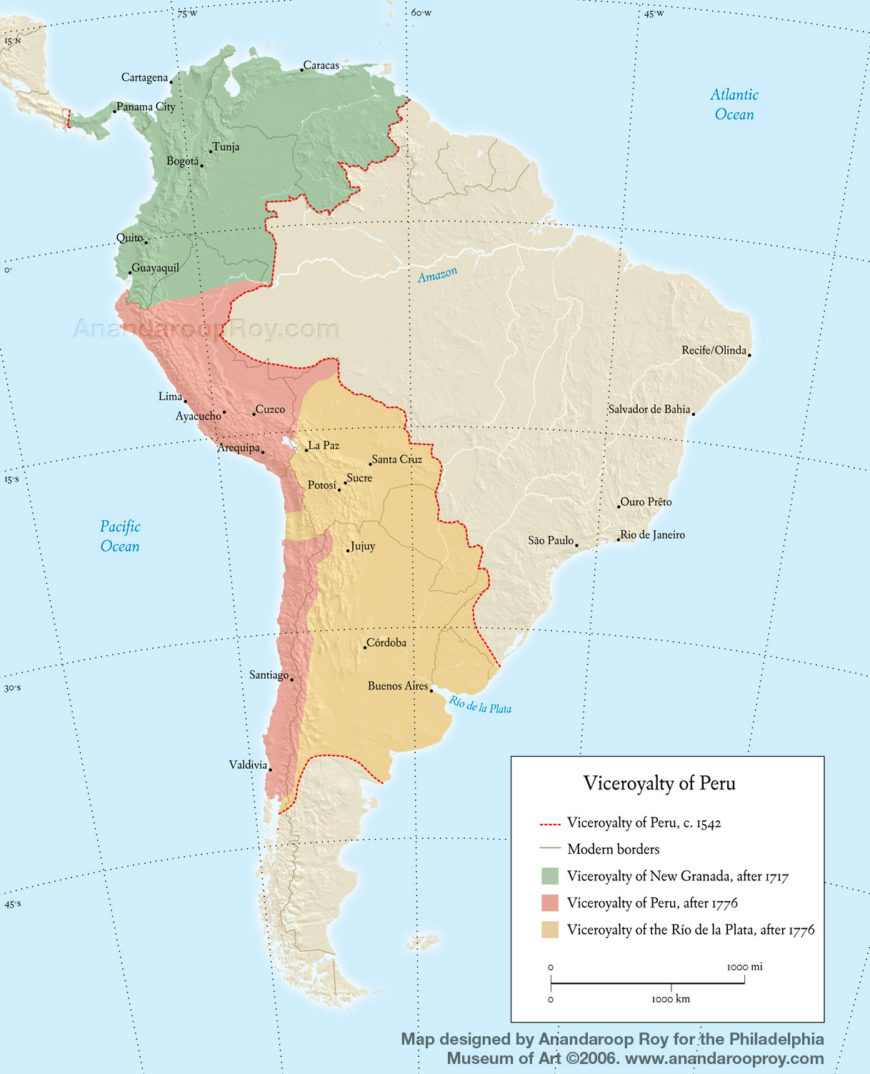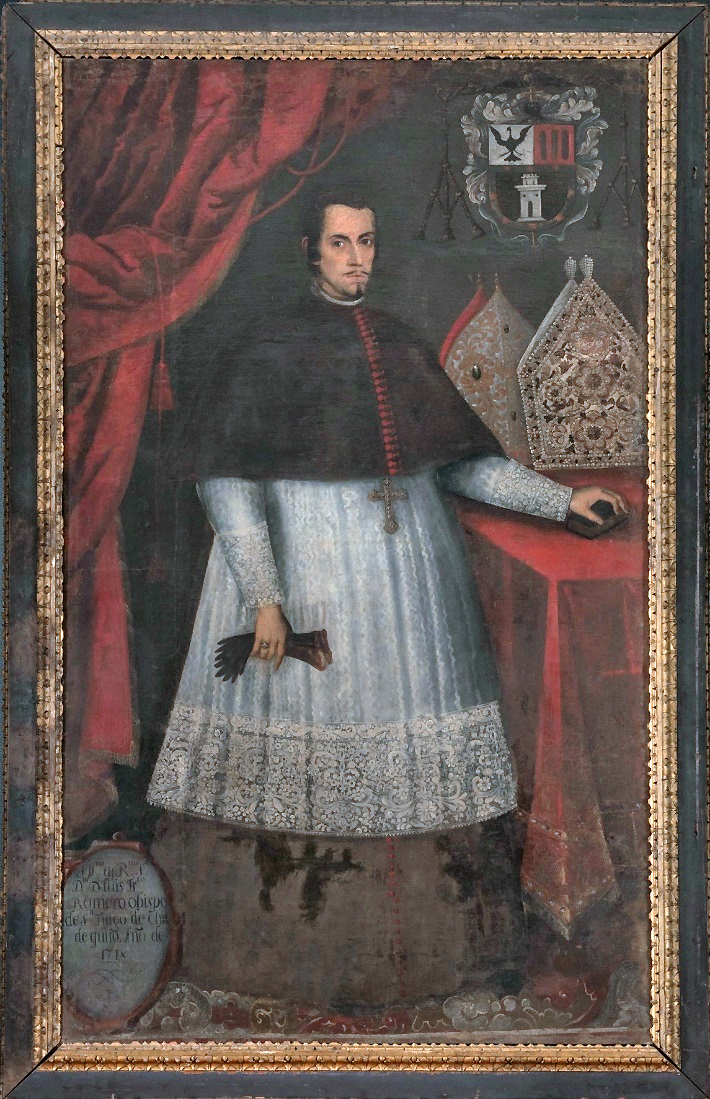
Unidentified artist, Luis Francisco Romero, Bishop of Santiago de Chile and of Quito, 1718, oil on canvas, 88 x 56 1/3” (Museo del Carmen de Maipú, Santiago, Chile)
A portrait of Luis Francisco Romero, Bishop of Santiago de Chile and Quito, shows this church official surrounded by emblems of his status and authority. Among these symbolic items, the pair of sumptuously adorned miters (the conical hat worn by a bishop) at his elbow conveys not only his position, but also his wealth. Never underestimate the power of a well-chosen accessory!
In the Viceroyalty of Peru, official portraits were instrumental in transmitting the power of secular and religious authorities. Their formulaic compositions contained a symbolic visual language that assisted viewers in recognizing a subject’s position and prestige. The individuals featured in such representations included governors, viceroys, bishops, and archbishops. Because these officials were overseen by Spanish kings, viceregal official portraits were an indispensable component of the Spanish colonial enterprise in the southern Andes (and throughout all the Spanish viceroyalties).
Created for display on the walls of government buildings and cathedrals, viceregal official portraits visualized the authorities who had presided over a region. Unlike secular official portraits, these religious paintings were often associated with the reassignment of their sitter to another jurisdiction. Images of Catholic bishops and archbishops were installed in sequence in the meeting rooms of cathedrals to remind successive officials of the accomplishments and ideals of their predecessors.
Portrait of Luis Francisco Romero
In one compelling example of colonial Andean religious portraiture we see Bishop Luis Francisco Romero, a powerful Spaniard stationed in South America, at a key transition in his career. This arresting image commemorated Romero’s reassignment to Quito, Ecuador in the newly formed Viceroyalty of New Granada following his decade-long stint as bishop of Santiago de Chile. Although its artist is currently unidentified, this work was produced in the Viceroyalty of Peru at an artistic center such as Cusco or Lima and was likely displayed in Santiago.
Romero owed his prominence as a religious official to the centrality of Spanish Catholic authority in the American viceroyalties. When Romero was approximately thirty years of age, King Philip V (the founder of the Bourbon dynasty in Spain) recommended his deployment to South America. In the decades that followed, he held high-level ecclesiastic positions throughout the Viceroyalty of Peru and, upon its initial establishment in 1717, in the Viceroyalty of New Granada. At each post, Romero functioned as a critical extension of imperial power, and as a result Philip V personally lauded his loyalty and service.
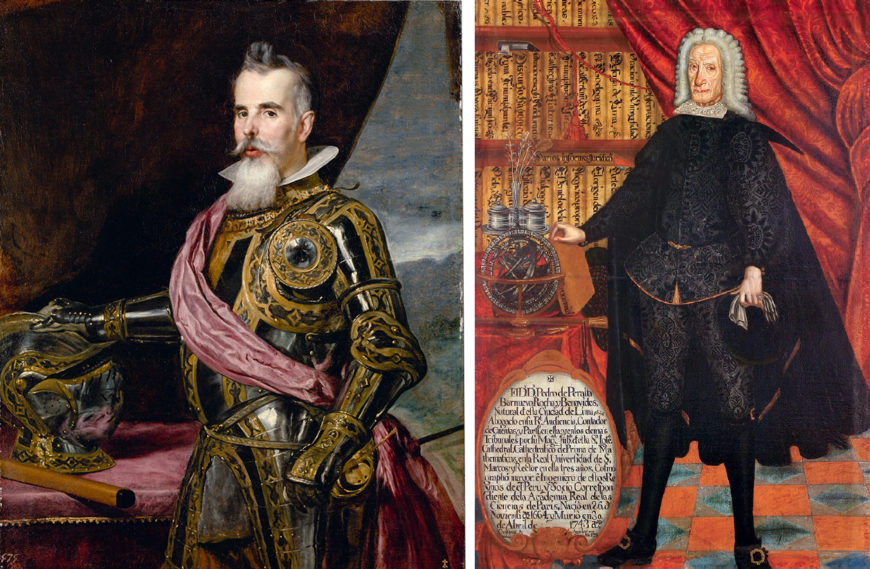
Left: Diego Rodríguez de Silva y Velázquez, Portrait of Juan Francisco de Pimentel, Count of Benavente, c. 1648, oil on canvas (Museo Nacional del Prado); right: Cristóbal de Aguilar, Portrait of Pedro de Peralta Barnuevo Rocha y Benavides, 1751, oil on canvas, 165 × 123 cm (Museo de Arte Universidad Nacional Mayor de San Marcos, Lima)
Portraiture in the Viceroyalty of Peru
Much of what we are seeing in the image of Bishop Romero exemplifies the pictorial conventions for official portraiture that were developed in Lima from Spanish court painting and subsequently adapted in other local artistic centers such as Cusco. In both Spanish and Andean traditions, we see the standing subject in an unspecific interior setting accompanied by a hat or crown, and other items that inform viewers of his station and accomplishments. To set off such scenes for audiences, a curtain is pulled aside as if to reveal the subject upon a stage. We can observe all of these characteristics in a Spanish portrait of Juan Francisco de Pimentel, Count of Benavente, in which his military rank is emphasized by his helmet and by the crimson general’s sash. Similarly, a portrait produced in Lima of Peruvian historian Pedro de Peralta Barnuevo employs a book, globe, and quill pens to emphasize the sitter’s intellectual achievements. This portrait also exemplifies how Andean painters retained the conventional formula and magnificence of the Spanish portraiture tradition, yet presented their sitters with a planarity and rich color palette that brought symbolic contents to the foreground.
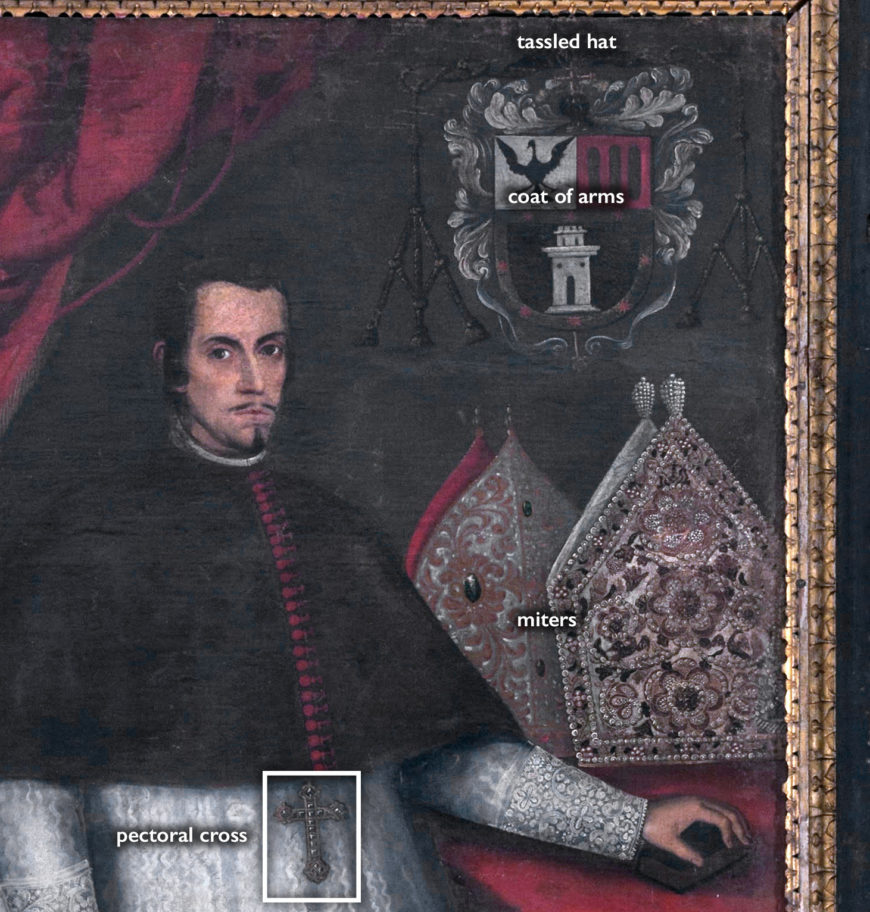
Detail of the painting’s upper half, Unidentified artist, Luis Francisco Romero, Bishop of Santiago de Chile and of Quito, 1718, oil on canvas, 88 x 56 1/3” (Museo del Carmen de Maipú, Santiago, Chile)
In keeping with this established formula, Romero wears the attire of his office and is surrounded by items that divulge his status, education, and wealth. For instance, we can locate his pectoral cross and ecclesiastic ring, both insignias of the office of bishop. Near Romero’s head we identify his familial coat of arms topped by a tasseled ecclesiastic hat.
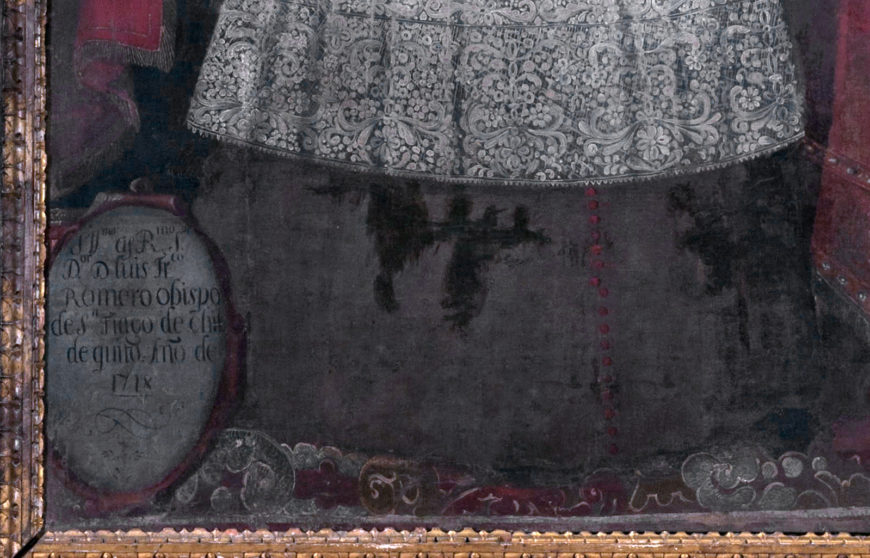
Detail of the cartouche and Bishop Romero’s clothes, Unidentified artist, Luis Francisco Romero, Bishop of Santiago de Chile and of Quito, 1718, oil on canvas, 88 x 56 1/3” (Museo del Carmen de Maipú, Santiago, Chile)
Another common convention in viceregal portraits is the inclusion of a textual cartouche to convey biographical information regarding the sitter, and occasionally the artist’s signature. In this painting, the text in the lower left corner imparts Romero’s role as Bishop of Santiago de Chile and of Quito in the year 1718. To reiterate this scripted message, the subject stands next to paired miters that symbolize his dual posts in Quito and Santiago de Chile. These miters are richly embellished to signify the eminence of both the Church and the sitter, as are the textiles arranged throughout the composition—we can identify miniscule lacework on the rochet, a red velvet curtain, patterned carpet, and delicate designs in metallic thread.
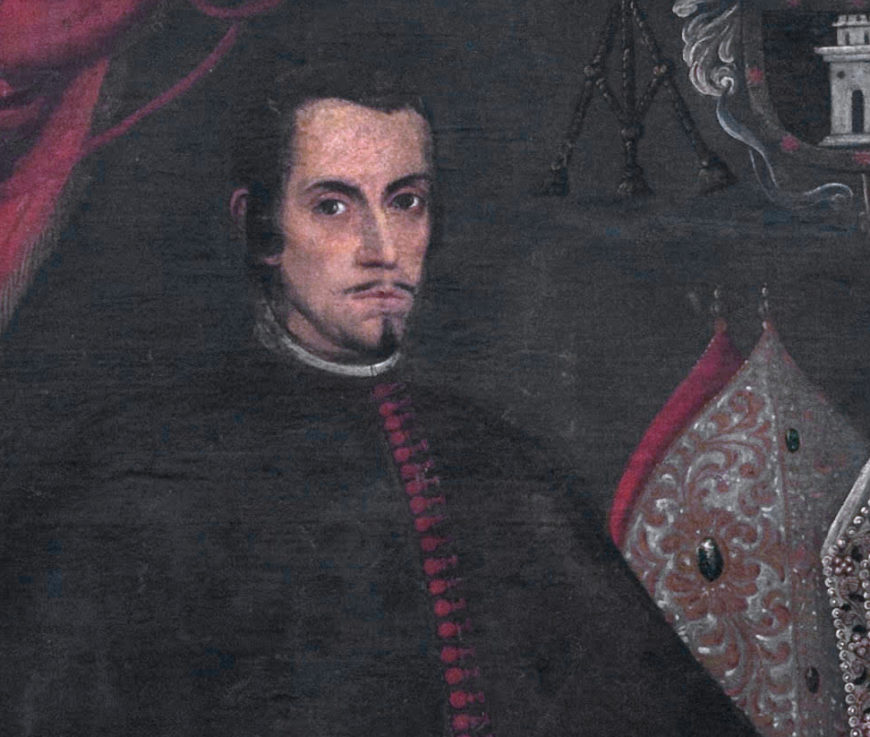
Detail of the painting’s upper half, Unidentified artist, Luis Francisco Romero, Bishop of Santiago de Chile and of Quito, 1718, oil on canvas, 88 x 56 1/3” (Museo del Carmen de Maipú, Santiago, Chile)
Was the Bishop really so stern?
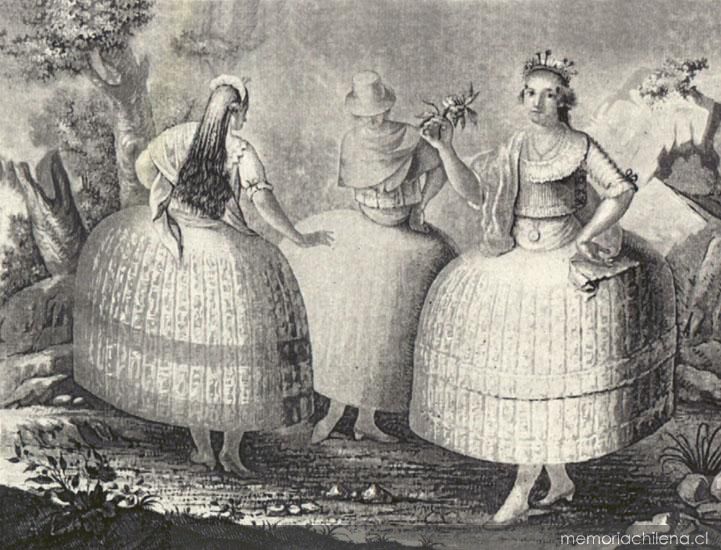
Chilean women wearing wide skirts. Fernando Brambilla, The Style of Dress Used by Chilean Women, 1790 (Biblioteca Nacional de Chile)
While sitters often meet the viewer’s stare, Bishop Romero’s gaze is atypically cold and gives the impression of scrutinizing onlookers. In portraiture, expressions can transmit ideas about the psychology and experiences of sitters, and Romero’s stern features may point to his famously obstinate personality and to his conservative agendas. While in Chile, he implemented strict Catholic protocols aimed at moderating the fashions of local women, particularly the ubiquitous wide skirt that left a portion of the lower leg in full view.
Heaven forbid the immodesty of a strong breeze on colonial Chilean streets!
Ostentation and Andean portraiture

Unidentified artist, Luis Francisco Romero, Bishop of Santiago de Chile and of Quito, 1718, oil on canvas, 88 x 56 1/3” (Museo del Carmen de Maipú, Santiago, Chile)
An image imbued with so much ostentation begs the question of its truthfulness. Did the official portraits produced in the Viceroyalty of Peru really convey the wealth of the sitter? Or were depicted luxuries—in this case, textiles, jewels, and a book—merely conventional symbols of status? Luis Francisco Romero’s personal inventory confirms that indeed he possessed significant collections of books and paintings, as well as ornate vestments and jewelry much like those seen in his portrait. Also registered in this written inventory were richly decorated miters like those displayed on the table; Romero owned a miter adorned with emeralds and another embellished with gold thread. The general correspondences between the luxury items listed in Romero’s personal inventory and those conveyed in his portrait suggest that, at least in this case, the ostentation of Andean official portraiture had significant basis in reality.
Taken altogether, the production of official religious portraiture in the Viceroyalty of Peru drew upon a visual vocabulary inherited from Spanish portraiture traditions and formalized in workshops at Lima to further imperialist agendas. This new pictorial language also drew upon Catholic symbolism and upon carefully selected visual elements that transmitted the status, prestige, and wealth of rendered subjects.

